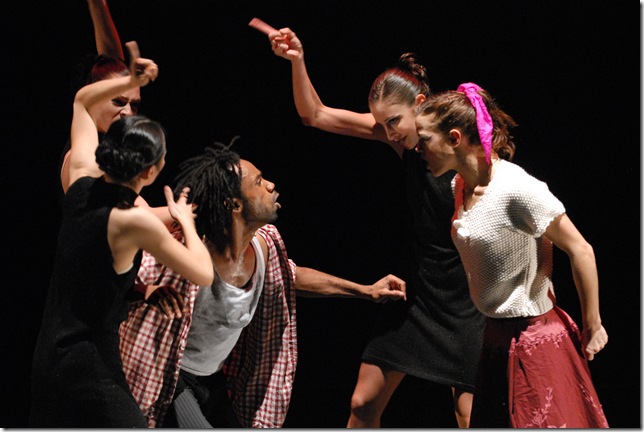By Tara Mitton Catao
The Duncan Theatre’s dance season came to a resounding finish with the explosive performance on Friday night of the Philadelphia-based Koresh Dance Company. Artistic director and choreographer Roni Koresh unleashed a movement vocabulary that was a fascinating flurry of endless invention.
As the show unfurled, one got a tremendous sense of the artistic integrity and the collaborative interaction that needed to occur for this vibrant performance to have taken place. All 10 dancers were excellent, beautifully trained, and fully dedicated to Koresh’s work and artistic vision.
The show had a feeling of enormous cohesiveness as well as expansive creativity. Koresh masterfully programmed his 15 separate works into a very artistically satisfying evening-length performance by weaving them together without breaks. He further unified them with a progression of evolving costume changes and a continuity in the vivid lighting (designed by Peter Jakubowski), which strongly etched and defined the visual space for both the dancers and the audience.
The first work was a full ensemble work, bright and welcoming, that introduced us to his outstanding dancers who lead us into the Koresh world. The profusion of fresh movement was skillfully sculpted, at first somewhat basically, as we adapted to the copious variety in the movement vocabulary, and later more complexly as it evolved into more layered choreographic structures.
Filled with duets and trios, the first 10 works ebbed and flowed and were tinged with humor. Another full company work, dark and fierce, closed the first half of the program. Danced with intensity, it nicely paired and contrasted with the opening work, showing an evolution from light to dark and from welcoming to almost defiant with its final assertive gesture of one arm reaching side and one arm raised in a fist.
Koresh’s works were choreographed to a vast array of music ranging from classical to contemporary. In Moonlight, Koresh choreographed to Ludwig van Beethoven and here, his signature style didn’t match in a traditional way with the music. It seemed to exist almost side by side. The vitality of the movement had a life of its own pulsing with the rhythms of the body. The physicality of the movement was pronounced and audible with its use of breath, hand thumping against body, and footsteps that slapped against the floor, holding their own depth and strength side by side with the music.
In the final work, Koresh had the courage to revisit Maurice Ravel’s famous Boléro. Attacking it straight on but under his terms, Koresh also named his work Bolero and chose to accentuate the unchanging rhythm that marches under the work rather than the melodies that dance over the work.
Wearing Goth-like black costumes, the dancers advanced in waves of increasing numbers and then retreated upstage, literally disappearing in a murky haze, only to reappear in another grouping. There was more unusual movement that the choreographer chiseled into a multitude of distinctively original shapes that wonderfully redefined Ravel’s famous music.
It was engrossing to watch the dancers move through the rapid unison movement with such clarity and shared intent.
There is a clear excellence in the Koresh Dance Company. If they come back, go see them. Experience the profusion of creativity and the acuity of the dancers as they execute unconventional, idiosyncratic movement. It is contemporary and pulsing. This is the art form alive.
